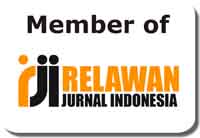Contributing Factors to The Students’ Speaking Ability
Abstract
The use of English in Indonesia has developed quickly in all of fields. It’s affected by many things in many ways. The need of English has also increased quickly in many parts of indonesians’ life. In order to face its, teaching English at young ages or student seems like the solution. Speaking is one of the skills that should be tough to the student. To get an effective learning, it’s useful to know what are factors contributing to the student speaking development. This research showed that there are some contributing factors to the students’ speaking development. Those factors are: Teacher, Daily Practice, Listening to English Music, Family Support, Watching English Video and Movie, Motivation to Learn, Classroom Environment, Learning Material. Such as a good teacher would provide a good learning. Support of the family would also give an effective outcome for the students development. So, the factors should be known in order to get a better outcome for the students.
Keywords
Full Text:
PDFReferences
Basher and Azeem. 2011. Factor Effecting Students’ English Speaking Skills. Retrivied from http://www.bjournal.co.uk/BJASS.aspx ©BritishJournal Publishing, Inc. on January 14, 2016
Brown, H. Douglas. 2001. Teaching by Principles: An Interactive Approach to Language Pedagogy. New York: Longman
Brown, H.Douglas. 2004. Language Assesment Principles and Classroom Practice. United States of America : Longman
Center for Teaching, Research & Learning. _____. Qualitative Research Introduction. Retrivied from Research Support Group at the Social Science Research Lab American University, Washington, D.C. http://www.american.edu/provost/ctrl/researchsupportgroup.cfm on December, 2015
Chen, Xiaotang. 1999. Asian Students` Reticence Revisited. Retrieved from
http://elechina.super-red.es/cheng.pdf. April 4, 2012
Copland , Fiona and Garton , Sue. 2104. Key themes and future directions in teaching English to young learners: introduction to the Special Issue. Retrivied from http://eltj.oxfordjournals.org on January 14, 2016
Dincer, Ali. Yesilyurt, Savas. 2013. Pre-Service English Teachers’ Beliefs on Speaking Skill Based on Motivational Orientations. Canadian Center of Science and Education. Vol. 6, No. 7. Retrivied from http://dx.doi.org/10.5539/elt.v6n7p88
Elfi. 2004. The Correlation between Self-Concept and Their Speaking Ability (Case Study at Third Semester English Department of STAIN Prof. Dr. H Mahmud Yunus Batusangkar). Unpublish Thesis. Batusangkar: STAIN Batusangkar
Gay, L. R., et al.. 2012. Educational Research : Competencies for Analysis and Applications. USA: Pearson
Harmer, Jeremy. 2004. The Practice of English Language Teaching. Malaysia: Longman.
Hoang Tuan, Nguyen. Ngoc Mai, Tran. 2015. Factors Affecting Students’ Speaking Performance at Le Thanh Hien High School. Asian Journal of Educational Research. Vol. 3, No. 2. Retrivied from : www.multidisciplinaryjournals.com.
Lado, Robert. 1961. Linguistic Across cultures:Apllied Linguistic for language Teachers. Michigan: University Michigan Press.
Laura Winanda. 2002. Teaching Speaking Using Picture Sets at SMU Level. Unpublished (Paper). Padang: Bung Hatta University
Lexy J Maleong. 2010. Metodology Penelitian Qualitatif. Bandung: PT Remaja Rosdakarya
Mahmoudi, Soheil and Mahmoudi Asgar. 2015. Internal and External Factors Affecting Learning English as a Foreign Language. International Journal of Language and Linguistics. Vol. 3, No. 5, 2015 retrivied from http://www.sciencepublishinggroup.com/j/ijll
Meihua, Liu. 2005. Causes of Reticence in EFL Classroom. A Study of Chinesse University Students. Retrieved from : http://www.indonesianjelt.org/Pages/Current_Issues.aspx?docname=/published_docs/20111014_025031_406.pdf on January, 2016
Miles B. Mathew, Huberman A. Michale. 1994. Qualitative Data Analysis. California: SAGE Publications
Mirhadizadeh, Nazanin . 2016. Internal and External Factors in Language Learning. International Journal of Modern Language Teaching and Learning . Vol. 1, Issue 5, 2016, pp.188-196 ISSN: 2367-9328 Available online at www.ijmltl.com
Nunan, David. 2003. Practical English for Young Learner. Singapore: Mc Graw Hill Company
Drajati, Nur Arifah. 2008. Peran Motivasi dan Strategi Belajar, dan Peranan Guru dalam Belajar Bahasa Kedua. Retrivied from http://icc-ptc.blogspot.com/2008/05/peran-motivasi-dan-startegi-belajar.html on july 2017
Pinter and Zandian. 2014. ‘I don’t ever want to leave this room’: benefits of researching ‘with’ children. Retrivied from http://eltj.oxfordjournals.org on January 14, 2016
Risnaneldi. 2001. Developing Students’ Speaking Ability. Journal of SMP Negeri 17 Pekan Baru. 56 - 58
Schreiber, James B., Asner-Self, Kimberly. 2011. EDUCATIONAL RESEARCH : The Interrelationship of Questions, Sampling, Design, and Analysis. USA: Jhon wiley & Son.inc
Sugiyono. 2012. Memahami Penelitian Kualitatif. Bandung: CV.Alfabeta
Tarigan, H Guntur. 1990. Prinsip-Prinsip Dasar Metode Riset Pengajaran dan Pembelajaran Bahasa. Bandung: Angkasa
Thornbury, Scott. 2005. How to Teach Speaking? . England: Longman Press
Ur, P. 2000. A course in Language Teaching: Practice and Theory. Combridge University Press
DOI: http://dx.doi.org/10.31332/lkw.v3i2.588
Copyright (c) 2018 Irwan Malin Basa

This work is licensed under a Creative Commons Attribution-ShareAlike 4.0 International License.
Langkawi: Journal of The Association for Arabic and English indexed by:


















.png)
.png)

.png)
2.png)








